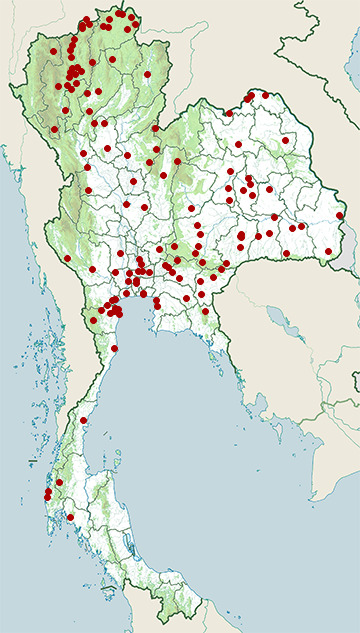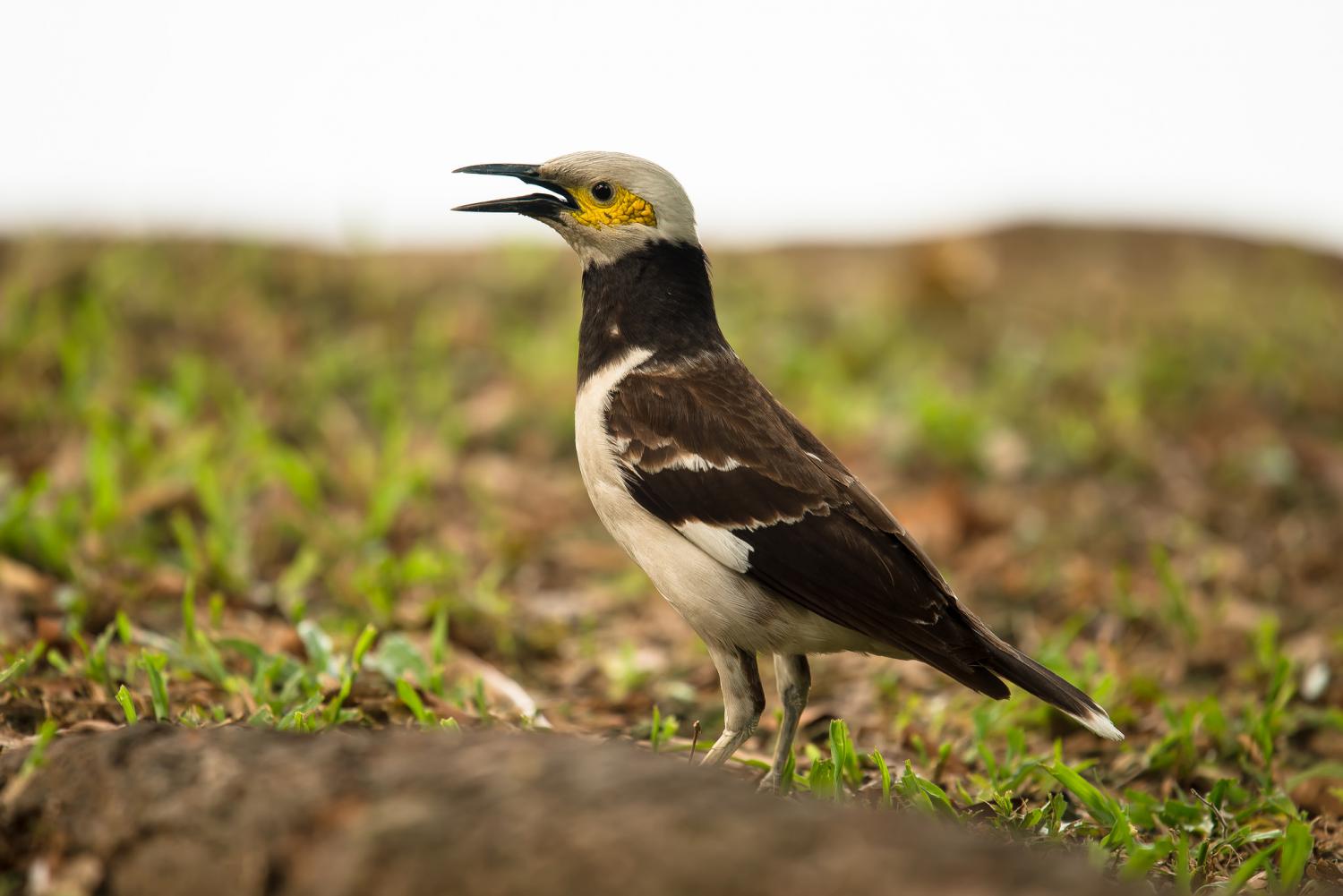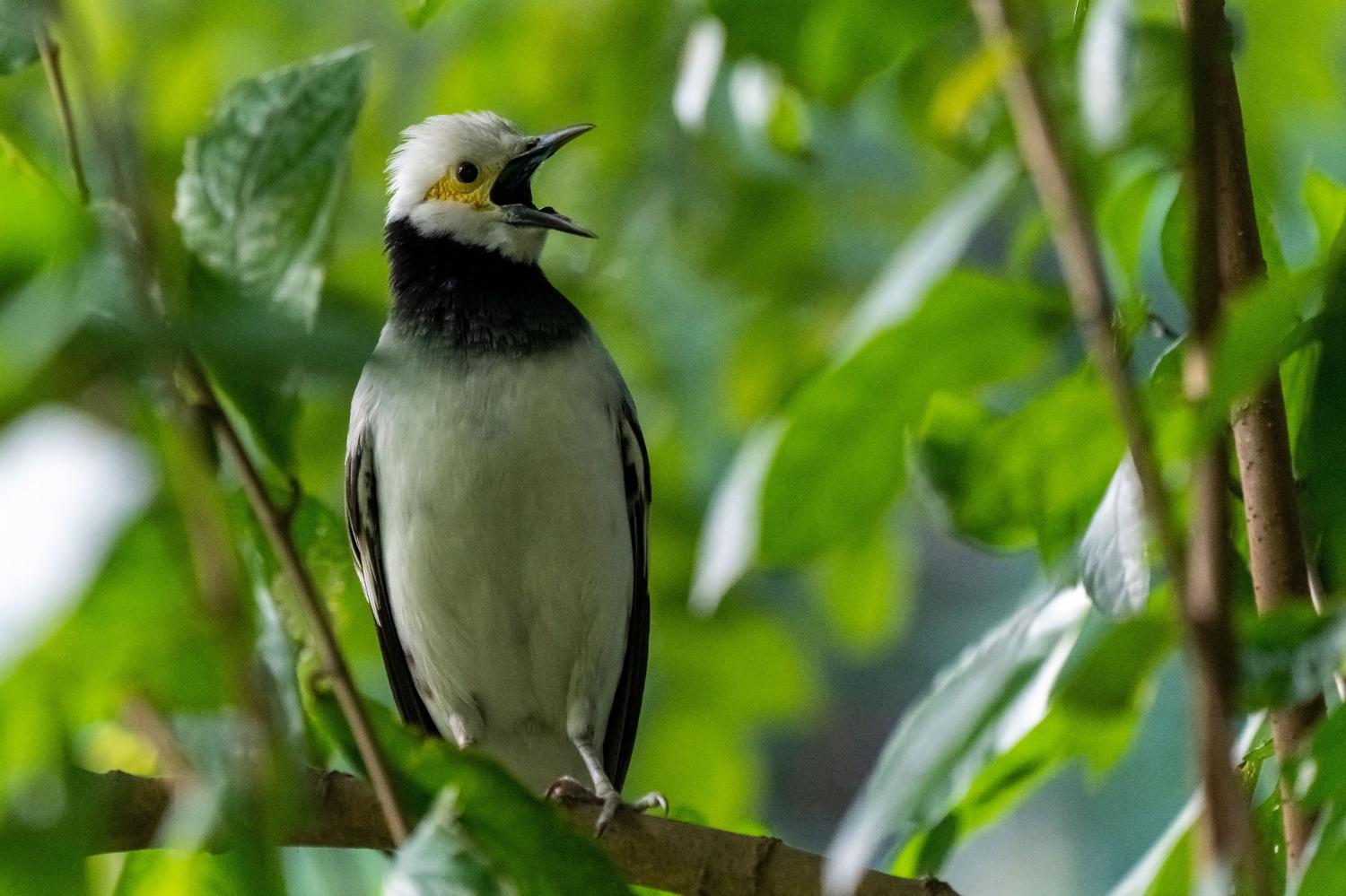Species of Thailand
Black-collared myna
Gracupica nigricollis
Gustaf von Paykull, 1807
In Thai: นกกิ้งโครงคอดำ
The black-collared starling (Gracupica nigricollis) is a species of starling in the family Sturnidae. Its plumage is black and white, with a black collar. It is found in southern China and most of mainland Southeast Asia, and has been introduced to Taiwan, Malaysia and Singapore. Its habitats include grassland, dry forest and human settlements. The International Union for Conservation of Nature (IUCN) has assessed it as being of least concern.
Taxonomy
This species was described as Gracula nigricollis by Gustaf von Paykull in 1807. Formerly placed in the genus Sturnus, it and the pied myna (Gracupica contra) were separated to the genus Gracupica when Sturnus was split, following phylogenetic studies in 2008. In the past it had also been placed in Sturnopastor, Acridotheres and Graculipica.
Description
The black-collared starling is 26 - 30 cm long. The head is white, with a yellow patch of bare skin around the eye, and a black collar around the neck. The mantle, back and wings are dark brown, appearing almost black. The underparts are white, often with a grey-brown tinge. The tail and most of the covert and flight feathers are tipped white, with the primary coverts completely white. The beak is black, and the legs are pale grey. The male and female are alike. The juvenile bird is browner and has a streaked neck and breast; it also has an eye-patch but not a collar.
Distribution and habitat
This species is found in southern China from Fujian to Yunnan, and south to Burma, Laos, Cambodia, Vietnam and Thailand. An individual recorded in Brunei may be an escaped captive or a vagrant. It has been introduced to Taiwan, Malaysia and Singapore. This starling lives in grassland, dry forest, cultivated areas and human settlements, mostly occurring at low elevations, but also up to 2000 m.
Behaviour
This starling forages on the ground, sometimes around livestock. It feeds on insects, earthworms and seeds. A very vocal bird, its calls include shrill, harsh, melodious and discordant notes, such as a jay-like kraak kraak, a whistling prrü resembling a bee-eater, and a pü-pü-pü-pü similar to a "hesitant" rufous-capped babbler. Its song is transcribed as tcheeuw-tchew-trieuw. Two courtship displays have been recorded. One consists of a pair facing each other, their feathers ruffled and beaks open. In the other, the pair droop their wings and bow their heads. Between displays, the pair run or fly after each other. Pairs also preen each other, a behaviour known as allopreening. The breeding season has been recorded as February to May in Thailand, March to July in China, and April to August in Burma. The large, domed nest is constructed from twigs, grasses, feathers and flowers. It is built on a tree, and may be re-used. Nesting colonies have been observed. Three to five eggs are laid per clutch.
Status
Deforestation seems to have benefited this species, causing its range to expand. The population appears to be increasing, and the IUCN has assessed it as a least-concern species.
This article uses material from Wikipedia released under the Creative Commons Attribution-Share-Alike Licence 3.0. Eventual photos shown in this page may or may not be from Wikipedia, please see the license details for photos in photo by-lines.
Category / Seasonal Status
BCST Category: Recorded in an apparently wild state within the last 50 years
BCST Seasonal status: Resident or presumed resident
Scientific classification
- Kingdom
- Animalia
- Phylum
- Chordata
- Class
- Aves
- Order
- Passeriformes
- Family
- Sturnidae
- Genus
- Gracupica
- Species
- Gracupica nigricollis
Common names
- Thai: นกกิ้งโครงคอดำ
Conservation status

Least Concern (IUCN3.1)
Photos
Please help us review the bird photos if wrong ones are used. We can be reached via our contact us page.
Range Map

- Amphawa District, Samut Songkhram
- Ban Laem District, Phetchaburi
- Ban Lat District, Phetchaburi
- Ban Phai District, Khon Kaen
- Bang Pa In District, Phra Nakhon Si Ayutthaya
- Bang Phra Non-Hunting Area
- Bang Pu Recreation Centre
- Bangkok Province
- Borabue District, Maha Sarakham
- Bueng Boraped Non-Hunting Area
- Chatturat District, Chaiyaphum
- Chiang Dao District, Chiang Mai
- Chiang Dao Wildlife Sanctuary
- Chiang Khong District, Chiang Rai
- Chiang Saen District, Chiang Rai
- Doi Inthanon National Park
- Doi Lang
- Doi Lo District, Chiang Mai
- Doi Pha Hom Pok National Park
- Doi Saket District, Chiang Mai
- Doi Suthep - Pui National Park
- Doi Tao District, Chiang Mai
- Fang District, Chiang Mai
- Hang Chat District, Lampang
- Huai Chorakhe Mak Reservoir Non-Hunting Area
- Huai Sala Wildlife Sanctuary
- Huai Talat Reservoir Non-Hunting Area
- Kaeng Khoi District, Saraburi
- Kaeng Krachan National Park
- Kamphaeng Saen District, Nakhon Pathom
- Kanthararom District, Sisaket
- Kantharawichai District, Maha Sarakham
- Khao Lak - Lam Ru National Park
- Khao Sam Roi Yot National Park
- Khao Sanam Prieng Wildlife Sanctuary
- Khao Soi Dao Wildlife Sanctuary
- Khao Sok National Park
- Khao Yai National Park
- Khao Yoi District, Phetchaburi
- Khlong Luang District, Pathum Thani
- Khun Chae National Park
- Khun Tan District, Chiang Rai
- Kumphawapi District, Udon Thani
- Kut Thing Non-Hunting Area
- Laem Pak Bia
- Lam Nam Kok National Park
- Mae Ai District, Chiang Mai
- Mae Chan District, Chiang Rai
- Mae Rim District, Chiang Mai
- Mae Taeng District, Chiang Mai
- Mueang Buriram District, Buriram
- Mueang Chiang Mai District, Chiang Mai
- Mueang Chiang Rai District, Chiang Rai
- Mueang Chonburi District, Chonburi
- Mueang Chumphon District, Chumphon
- Mueang Kanchanaburi District, Kanchanaburi
- Mueang Khon Kaen District, Khon Kaen
- Mueang Krabi District, Krabi
- Mueang Lampang District, Lampang
- Mueang Lamphun District, Lamphun
- Mueang Maha Sarakham District, Maha Sarakham
- Mueang Nakhon Nayok District, Nakhon Nayok
- Mueang Nakhon Ratchasima District, Nakhon Ratchasima
- Mueang Nan District, Nan
- Mueang Nong Khai District, Nong Khai
- Mueang Nonthaburi District, Nonthaburi
- Mueang Phayao District, Phayao
- Mueang Phetchabun District, Phetchabun
- Mueang Phetchaburi District, Phetchaburi
- Mueang Phitsanulok District, Phitsanulok
- Mueang Prachinburi District, Prachinburi
- Mueang Sa Kaeo District, Sa Kaeo
- Mueang Samut Sakhon District, Samut Sakhon
- Mueang Samut Songkhram District, Samut Songkhram
- Mueang Sisaket District, Sisaket
- Mueang Sukhothai District, Sukhothai
- Mueang Suphanburi District, Suphan Buri
- Mueang Surin District, Surin
- Mueang Tak District, Tak
- Na Chaluai District, Ubon Ratchathani
- Nam Nao National Park
- Non Din Daeng District, Buriram
- Non Thai District, Nakhon Ratchasima
- Nong Bong Khai Non-Hunting Area
- Nong Han Lake
- Nong Song Hong District, Khon Kaen
- Nong Ya Plong District, Phetchaburi
- Omkoi Wildlife Sanctuary
- Op Khan National Park
- Pa Sang District, Lamphun
- Pai District, Mae Hong Son
- Pak Chong District, Nakhon Ratchasima
- Pak Khat District, Bueng Kan
- Pak Phli District, Nakhon Nayok
- Pak Thale
- Pak Thong Chai District, Nakhon Ratchasima
- Pang Sila Thong District, Kamphaeng Phet
- Pha Daeng National Park
- Pha Taem National Park
- Phaisali District, Nakhon Sawan
- Phra Nakhon Si Ayutthaya District, Phra Nakhon Si Ayutthaya
- Phu Hin Rong Kla National Park
- Phu Suan Sai National Park
- Phutthamonthon District, Nakhon Pathom
- Rattanaburi District, Surin
- Rattanawapi District, Nong Khai
- Sai Noi District, Nonthaburi
- Sai Yok National Park
- Sakaerat Environmental Research Station
- Samut Prakan Province
- San Sai District, Chiang Mai
- Sanam Bin Reservoir Non-Hunting Area
- Si Maha Phot District, Prachinburi
- Si Satchanalai District, Sukhothai
- Si Satchanalai National Park
- Sikhoraphum District, Surin
- Sop Prap District, Lampang
- Ta Phraya National Park
- Takua Pa District, Phang Nga
- Taphan Hin District, Phichit
- Tha Takiap District, Chachoengsao
- Thanyaburi District, Pathum Thani
- Thap Lan National Park
- Thawat Buri District, Roi Et
- Thung Salaeng Luang National Park
- Wang Nam Yen District, Sa Kaeo
- Wapi Pathum District, Maha Sarakham
- Wat Phai Lom & Wat Ampu Wararam Non-Hunting Area
- Watthana Nakhon District, Sa Kaeo
- Wiang Kaen District, Chiang Rai

